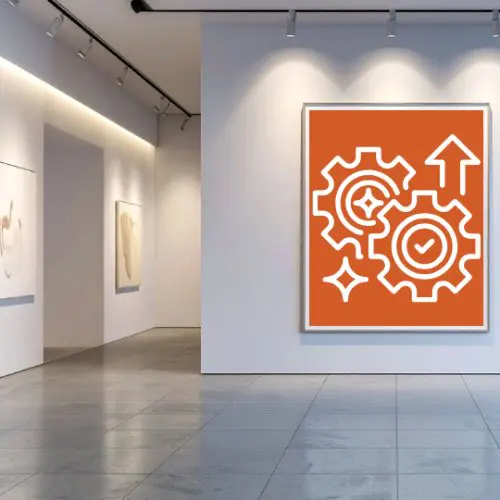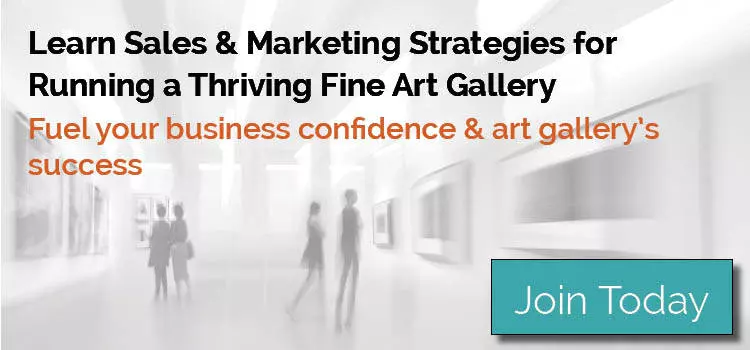 The art market is shifting in subtle but meaningful ways. Collectors are using new tools to discover art, the emotional motivations behind purchases are evolving, and the identity of what a gallery is (and does) is expanding. For small and mid-sized galleries—often running on lean teams and tight margins—these shifts require clarity of direction and deliberate planning.
The art market is shifting in subtle but meaningful ways. Collectors are using new tools to discover art, the emotional motivations behind purchases are evolving, and the identity of what a gallery is (and does) is expanding. For small and mid-sized galleries—often running on lean teams and tight margins—these shifts require clarity of direction and deliberate planning.
This is why it is important to step back at least once a year and evaluate not only what your gallery has been doing, but what you want the business to look like three to five years from now. Without this reflection, galleries fall into “maintenance mode,” where the day-to-day dictates strategy rather than the other way around. But the galleries that grow sustainably are the ones that create systems that support consistency, so the owner and staff are not constantly reacting to the most urgent task at hand.
As you plan the next phase of your business development, here are key trends shaping the gallery sector today—and ways you can implement them in your workflow.
Prioritizing Client Relationships Beyond the Transaction
Client loyalty is one of the strongest business drivers a gallery has, but loyalty is built between purchases, not at the moment of sale. It is easier to keep a client than find new ones. Many of Gallery Fuel members intend to stay in touch, but struggle to be proactive. The solution is to create a simple, repeatable system for outreach rather than relying on memory or spontaneity.
Here are some ideas to help you.
- Create a list of your top 25–50 collectors and schedule quarterly personal check-ins. These don’t need to be sales-driven—instead, share a short insight about an artist’s process, recent press, or a cultural trend related to their taste. These need to personal notes/emails, not newsletters blasted to all.
- After every sale, schedule a follow-up touchpoint 3–4 weeks later in your CRM or email calendar—just to check in, thank them again, and ask how the piece is settling into their space.
- Track collector preferences more intentionally. Even noting their color palette preferences, favorite mediums, or price comfort range allows you to send highly relevant personal previews later.
This kind of thoughtful contact is what makes a collector feel like a partner in the gallery’s mission—not just a customer.
Building Management Systems That Support Growth
Small galleries rarely have the staffing needed to divide responsibilities cleanly, which means tasks like marketing, administration, and sales often fall on the same person. One important shift in recent years is the growing accessibility of fractional support—specialists who work with you part-time, project-based, or remotely.
For example:
- A part-time marketing assistant can prepare exhibition announcements, update the website, or schedule social media posts—freeing you to focus on relationship building.
- A freelance gallery administrator can help with inventory records, artist agreements, or press packets.
- A contracted videographer or editor can produce short-form video content of exhibitions or artist conversations.
The key is to treat outsourcing not as a luxury, but as a strategic investment in the capacity of your gallery to grow. Even 5–10 hours per month can make a measurable difference.
Galleries are increasingly and more intentionally communicating their values—not only what they show, but why. This includes curatorial intention, relationship to community, and sustainability practices. If your gallery uses eco-conscious shipping materials, frames, or exhibition display methods, brag about that. Your prospective buyers will want to support your business over a faceless online marketplace. If your artists source materials sustainably or work with reclaimed objects, highlight it in wall text and online as well. Collectors, especially the younger buyers, love businesses that reflect their values, but clarity is required—it must be visible and consistent.
Extending the Sales Cycle to Deepen Engagement
Art buyers often want more understanding and emotional connection before purchasing. This is where programming that surrounds an exhibition becomes strategically important. Don’t put pressure on yourself to make these elaborate events; the key is offering multiple entry points for engagement.
For instance:
- Host an informal “Coffee with the Curator, Gallery Director or Artist” walkthrough for local collectors.
- Offer a brief, recorded artist conversation that can live on your website, playing in the gallery and in your sales outreach emails.
- Create a one-page exhibition “context guide” that explains themes, references, and artistic decisions. This is especially helpful for newer collectors developing their visual literacy.
When you provide meaningful context, you help collectors feel more confident. Confidence is one of the strongest drivers in art purchases.
Pricing transparency also continues to be a must. Clear pricing—both in the gallery and online—signals trust and respect for your collectors’ intelligence. And as online discovery expands in the sales journey, so does the importance of reviews and testimonials. Don’t be shy about asking collectors to share their experience. A few sentences from a happy buyer displayed on a website, social media pages, or in email newsletters can reinforce credibility more effectively than any sales language. Make this part of your post-sales process.
Marketing That Blends Storytelling, Community, and Accessibility
Short-form video has become one of the most effective ways for galleries to connect with audiences, but it does not require polished production or on-camera performance. Viewers respond to authenticity:
- Show an artist preparing for an exhibition.
- Film a quiet slow pan of an artwork up close.
- Capture your own voice talking about what drew you to an artist’s work.
These pieces of content serve not just marketing—but education and connection. Start to build a library of video content that can also be used more evergreen for follow-up assets with sales leads. For example, shoot a little video every time you visit an artist’s studio.
At the same time, long-form content remains essential for SEO and audience trust. Blog posts, interviews, or exhibition essays can be designed to be highly skimmable while still providing depth. This is especially true for attracting new collectors who are self-educating online before ever even engaging with your gallery.
Partnerships continue to be a powerful way to reach new audiences while sharing costs. Consider collaborations with:
- Local hospitality businesses
- Architecture and design studios
- Cultural non-profits
- Other galleries in your region (yes, try to view as potential partners vs. competitors when appropriate)
These partnerships reinforce your gallery as a cultural connector and expand your audience without additional advertising spend.
To the Point
The gallery landscape is changing, but this period of change is also one of opportunity. Kinda exciting, isn’t it?
Collectors want connection, meaning, and alignment—and small galleries are uniquely positioned to offer that with intimacy and authenticity. Just keep in mind that this is easier to deliver if you don’t take on too many projects throughout the year and allow yourself the time and resources to go deep vs offering more with less context.
By building more intentional relationship practices, strengthening your operational structure, creating layered exhibition experiences, and telling your story consistently across platforms, you will create a business model that is both sustainable and human-centered.
Your work in the art market today is very important. And with thoughtful planning, it can also be more efficient, more fulfilling, and more impactful—for your artists, your collectors, and your community – and you!
You may also enjoy these articles.
The Art Gallery Business Model and Operational Structure
Adopting Technology for Running an Art Gallery Business



Leave a Reply